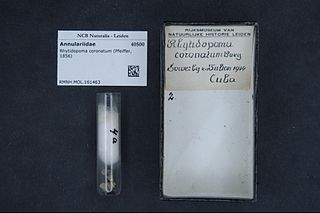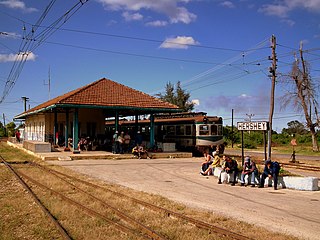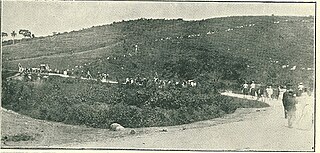
Boca de Jaruco is a small fishing village in the Mayabeque Province of Cuba. It is located in the municipality of Santa Cruz del Norte, at the mouth of the Rio Jaruco, on the Straits of Florida.

Jibacoa, or more properly Playa Jibacoa, is a fishing village in the Mayabeque Province of Cuba. It is located in the municipality of Santa Cruz del Norte, at the mouth of the Jibacoa River, 60 km east of Havana.

Jaruco is a municipality and town in the Mayabeque Province of Cuba.

Arcos de CanasíBacunayagya is a Cuban village and consejo popular of the municipality of Santa Cruz del Norte, in Mayabeque Province. Until 2011, it was part of the former La Habana Province.
The Lecuona Cuban Boys was a popular Cuban orchestra which toured the world for over forty years.

Bacunayagua is a Cuban village and consejo popular of the municipality of Santa Cruz del Norte, in Mayabeque Province. In 2011 it had a population of 3,371.
Maximiliano de la Luz Borges y del Junco was a well-known Cuban architect and Minister of Public Works during the presidency of Dr. Federico Laredo Brú of Cuba.
Punto guajiro or punto cubano – or simply punto – is a sung genre of Cuban music, a poetic art with music. It became popular in the western and central regions of Cuba in the 17th century, and consolidated as a genre in the 18th century. It has Andalusian and Canary Islands origins, and it integrated African elements in Cuba.
Jose D. "Lolo" Villalobos y Olivera was a Cuban politician.

The Hershey Electric Railway, also known as the Hershey Railway, is a standard-gauge electric interurban railway that runs from Casablanca, Havana, to the city of Matanzas, approximately 92 kilometres (57 mi) to the east. There are a number of intermediate halts and a station and depot at the town of Camilo Cienfuegos, better known by its pre-revolutionary name of Hershey. The railway is the only surviving electric line in Cuba. The railway was built by The Hershey Company to transport sugar to the port of Havana. The original electric interurban cars were bought from the JG Brill Company, but these were replaced by 60-year old cars from the Ferrocarrils de la Generalitat de Catalunya in the 1990s.

Rhytidopoma coronatum is a species of an operculate land snail, terrestrial gastropod mollusk in the family Pomatiidae.

Major General José María Aguirre was a Cuban soldier in the Cuban War of Independence (1895–1898), the last of three liberation wars that Cuba fought against Spain. He was with Enrique Collazo and was connected with the newspaper Protesta. After being wounded in 1896 he died of pneumonia out in the lomas of Jaruco. The José María Aguirre T9 medical school is named in his honour.

Hershey is a Cuban village and consejo popular of the municipality of Santa Cruz del Norte, in Mayabeque Province.

Cayo Hueso is a consejo popular (ward) in the municipality of Centro Habana, Havana, Cuba. A traditionally working-class neighborhood populated by Afro-Cubans, it is known for its many cultural landmarks such as the Callejón de Hamel, the Fragua Martiana Museum and the Parque de los Mártires Universitarios.
Artigasia is a genus of nematodes belonging to the family Hystrignathidae. It was described from the gut caeca of Passalus interstitialis from Escaleras de Jaruco, La Habana Province, and El Pan de Matanzas, Matanzas Province, both in Cuba.

Floridanos is a term for colonial residents of Spanish Florida, as well as for the modern descendants of the earliest Spanish settlers who lived in St. Augustine between 1565 and 1763 and Hispanic Immigrants coming from Hispanic nations like Cuba. It also refers to those of Spanish descent who lived in East and West Florida after 1781, when Bernardo de Gálvez took back Mobile and Pensacola in West Florida from British hands. Some Floridanos can trace their ancestry in Florida back twelve or more generations. Descendants of the original Floridanos can be found throughout the state, especially in St. Augustine, as well as in Miami, Tampa, and Orlando.

The Lanzadera Campaign was a significant part of the Cuban War of Independence as it was the next operation of the Mambises by Máximo Gómez to distract Spanish troops to him and avoiding their pressure on Antonio Maceo, who was able to continue to the West to complete the Invasion from East to West in Cuba. The campaign was considered to be one of skillful maneuvering, mobility and oversight as Gómez's vastly outnumbered 2,000 Mambises had achieved their goals with negligible losses against the 40,000 Spanish infantry which was commanded by Arsenio Martínez Campos, Sabás Marín and Valeriano Weyler.












